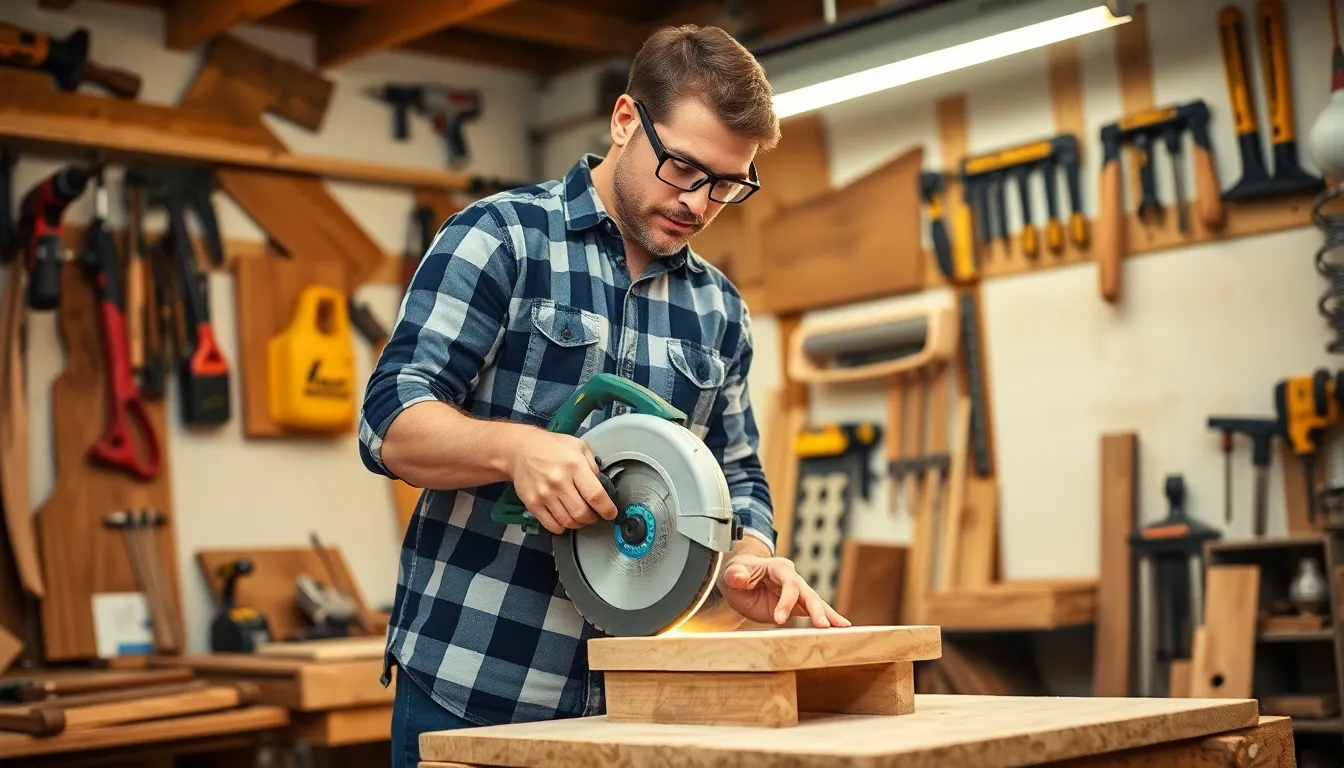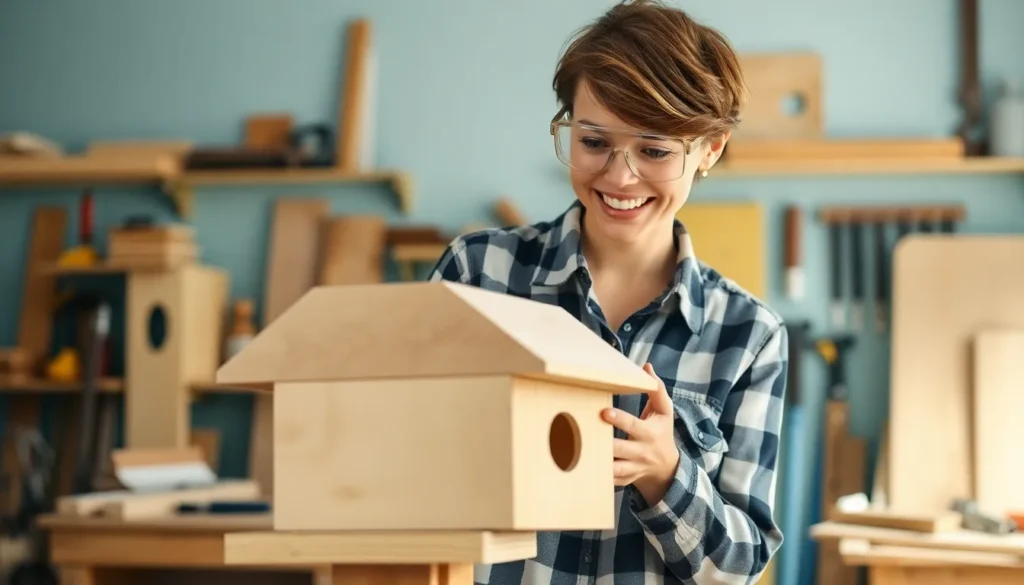Woodworking isn’t just for the pros with beards and tool belts; it’s a playground for anyone looking to unleash their inner craftsman. Whether you’re a seasoned woodworker or just starting out, there’s something undeniably satisfying about transforming a simple piece of lumber into a masterpiece. And let’s be honest, who wouldn’t want to impress friends with a handmade cutting board or a quirky birdhouse?
Imagine the joy of creating something unique with your own two hands—no assembly required! From whimsical decor to practical home items, fun woodworking projects can spark creativity and provide a sense of accomplishment. So grab that saw, dust off that workbench, and dive into a world where sawdust is your confetti and every project is a chance to show off your skills (or at least your ability to wield a hammer without losing a finger).
Fun Woodworking Projects
Engaging in fun woodworking projects offers numerous advantages. Participants often experience an increase in creativity and practical skills while enjoying the process.
Enhancing Creativity
Woodworking encourages creative expression. Individuals can experiment with designs, materials, and techniques. Exploring new ideas leads to unique pieces, reflecting personal style. Creativity thrives in a hands-on environment, boosting problem-solving abilities and innovative thinking. Many woodworkers find joy in transforming simple wood into art, fueling their imagination further.
Building Practical Skills
Participating in woodworking develops various practical skills. Users sharpen techniques such as measuring, cutting, and assembling materials. Gaining proficiency in tool handling enhances confidence and competence. Building projects requires critical thinking, fostering an ability to troubleshoot and adapt. Furthermore, tackling different projects deepens project management skills, from planning to execution. Acquiring these skills not only benefits woodworking but also transfers to everyday tasks.
Essential Tools For Woodworking

Essential tools enhance the woodworking experience, making projects more manageable and enjoyable. Beginners benefit from understanding essential and optional tools that can elevate their craftsmanship.
Basic Tools Every Woodworker Needs
Every woodworker requires specific tools to start. A saw is critical for cutting wood, whether it’s a hand saw or circular saw. Measuring tools, like tape measures and squares, ensure precision in projects. Drills facilitate making holes for fasteners, while chisels help refine details. Clamps secure pieces during assembly, providing stability and accuracy. Safety goggles protect eyes from debris, promoting a safe working environment. Each tool supports efficiency and precision, essential for quality woodworking.
Optional Tools To Consider
Optional tools can enhance the woodworking experience. A jigsaw enables intricate cuts for unique designs. Routers add decorative edges and grooves to pieces, contributing to aesthetic appeal. Sanding tools, like orbital sanders, smooth surfaces, reducing finishing time. A miter saw aids in making precise angle cuts, especially useful for framing projects. Dust collectors maintain a clean workspace, improving visibility and safety. Investing in these tools enhances capabilities, allowing for more complex and creative projects.
Fun Woodworking Projects For Beginners
Engaging in woodworking projects is perfect for beginners seeking to develop skills while enjoying creativity. Several enjoyable projects can introduce basic techniques.
Simple Birdhouse
Creating a simple birdhouse provides a great starting point. Choose materials like untreated wood to ensure safety for birds. Follow straightforward steps, such as measuring and cutting the wood into panels. Assemble the panels using screws or nails, and don’t forget ventilation and drainage holes. Painting or decorating the birdhouse adds a personal touch. This project teaches essential skills such as measuring and assembly, while fostering a love for nature and outdoor activities.
Wooden Coasters
Crafting wooden coasters serves as another fun beginner project. Select hardwood for durability and finish. Cut the wood into squares or circles measuring around 4 inches. Sand the edges for a smooth surface and apply a protective finish to resist moisture. Personalizing each coaster with designs or decorative engravings enhances the overall appeal. Completing this project improves woodworking precision and allows for creative expression, making coasters practical items for everyday use.
Intermediate Woodworking Projects
Intermediate woodworking projects offer a chance to refine skills while creating functional pieces. Each project enhances craftsmanship and encourages creativity.
Sturdy Bookshelves
Building sturdy bookshelves strengthens skills in measuring, cutting, and assembling. Use quality wood and precise measurements for a finished product that adds durability and style to any space. Consider incorporating adjustable shelves to accommodate various book sizes. This flexibility appeals to many readers. Additionally, adding decorative elements, such as molding, can enhance the visual impact of the piece. By creating custom finishes, woodworkers can reflect personal tastes and match existing decor. Use appropriate joinery techniques, like pocket holes or dowels, for added stability.
Rustic Picture Frames
Crafting rustic picture frames provides an excellent opportunity to experiment with textures and finishes. Start with reclaimed wood to create a unique aesthetic. Each frame can highlight the beauty of individual photos while adding a personal touch to home decor. Varying widths and bevels in the frame design can draw attention to the artwork it holds. Utilize simple woodworking techniques, such as mitered corners, to ensure a polished look. Personalize frames with stains or paints for additional customization. A final touch, like a distressed finish, can emphasize the rustic charm, making each frame a cherished piece.
Advanced Woodworking Ideas
Advanced woodworking projects offer opportunities to create unique and functional pieces that showcase craftsmanship. Engaging in these endeavors can significantly enhance woodworking skills.
Stylish Furniture
Creating stylish furniture stands out as a rewarding challenge. Crafting a modern coffee table demonstrates the combination of function and design. Select quality hardwood for durability and aesthetics. Use dovetail joints for a strong connection that enhances visual appeal. Incorporating inlays can add a personalized touch, making the piece truly one-of-a-kind. Consider finishing with varnish or oil to showcase the natural beauty of the wood. Building stylish furniture pairs creativity with practicality, attracting attention and elevating any space.
Intricate Wooden Toys
Designing intricate wooden toys presents an enjoyable way to merge creativity with functionality. Crafting a detailed puzzle, for example, nurtures imaginative play while honing fine motor skills. Choose vibrant, non-toxic paints to make the toys visually appealing and safe for children. Incorporate movable parts in designs such as pull-along animals or building blocks to add interactivity. Each piece can be customized, reflecting personal touch while engaging young minds. Constructing intricate wooden toys blends artistry with purpose, fostering joy in both the creator and the recipient.
Tips For Successful Woodworking
Successful woodworking relies on planning and care. Focusing on safety and choosing suitable materials leads to better outcomes.
Safety First
Safety must always come first in woodworking. Protective gear like safety goggles, dust masks, and ear protection guards against hazards. Ensuring a clean workspace prevents accidents, while proper tool handling minimizes risks. When using power tools, familiarity with their operation helps avoid injuries. Having a first aid kit nearby provides peace of mind in case of emergencies. Taking these precautions ensures a safer and more enjoyable woodworking experience.
Choosing The Right Wood
Choosing the right wood affects project quality and appearance. Softwoods like pine and cedar are ideal for beginners, as they are easier to work with and cost-effective. Hardwoods such as oak and maple offer durability and a beautiful finish, perfect for advanced projects. Understanding wood characteristics, like grain patterns and stability, helps in selecting suitable options. Knowing the intended use guides the wood choice as well. Planning ahead allows for smoother crafting and enhances the final product’s aesthetic.
Conclusion
Woodworking offers a fulfilling way to express creativity and develop practical skills. Whether someone is a beginner or an experienced craftsman they can find joy in creating unique pieces that reflect their personal style. The various projects outlined provide an opportunity to learn and grow while enjoying the process of crafting.
With the right tools and a focus on safety anyone can embark on this rewarding journey. By exploring different projects from simple birdhouses to intricate furniture designs woodworkers can continually challenge themselves and refine their skills. Embracing woodworking not only enhances creativity but also fosters a sense of accomplishment that comes from bringing ideas to life.

